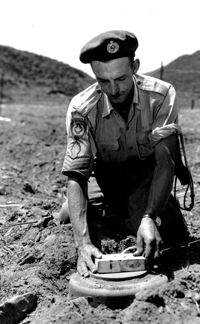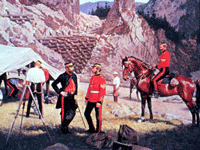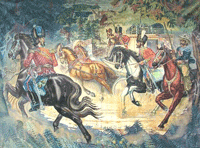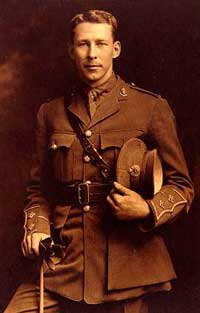
"He is a man [and now woman] of all work of the army and the public: astronomer, geologist, surveyor, draftsman, artist, architect, traveler, explorer, antiquary, mechanic, diver, soldier and sailor; ready to do anything or go anywhere; in short, he is a sapper." Capt T.W.J. Connolly, Royal Engineer Historian (1815-1885)

"He is a man of all work of the army and the public: astronomer, geologist, surveyor, draftsman, artist, architect, traveler, explorer, antiquary, mechanic, diver, soldier and sailor; ready to do anything or go anywhere; in short, he is a sapper." Capt T.W.J. Connolly (1815-1885), Royal Engineer Historian
The term "sapper" has been associated with engineers for many generations. The origin of this term lies in the French word "sape," meaning undermine and the Middle French word "sap" that was a spade or a hoe. The dictionary defines a "sap" as a trench that is prolonged by digging away the earth from within the trench itself.
In medieval times, when armies laid siege to a fortification, one of the common methods of breaching the defenses was to dig a trench, or "sap," up to the base of the castle wall. A tunnel would then be dug under, or into, the wall. Prior to the introduction of explosives, a breach of the defensive wall would be accomplished by replacing blocks of stone with wooden supports. The supports would then be burned causing a section of wall to collapse. In the French Army, digging a trench under fire was known as "driving a sap" and the men who did this were known as "sapeurs." Thus, the terms "sappers" became associated with engineers. After the discovery of gunpowder, an explosive "mine" was used to breach the wall. This task was, of course, also the responsibility of the engineers.
In 1813, the Royal Engineers officially adopted the title Royal Sappers and Miners and, in 1856, the rank of the common soldier was changed from private to sapper. The CME has continued to use this designation and, just as privates in the artillery are referred to as "gunners," field engineers of the rank of private are referred to as "Sappers." A sapper should always be addressed as Sapper Smith, not as Private Smith. The term may also be used to refer to a group of field engineers who are not necessarily of the rank of private: for example, "here come the sappers to breach the minefield." All ranks in field engineer units traditionally referred to themselves as sappers because other trades in the unit were first trained as field engineers. Today it is primarily combat engineers that are referred to as sappers.

3. What do the Military Engineers do?
Military engineers throughout the world are integrated members of the profession of arms. Internationally, military engineers share a common background in a discipline that encompasses the use of demolitions and land mines, the design, construction and maintenance of defensive works and fortifications, lines of communications, and bridges. They also provide water, power and other utilities, provide fire, aircraft crash and rescue services, hazardous material operations, and develop maps and other engineering intelligence. In addition, military engineers are experts in deception and concealment, as well as the design and development of equipment necessary to carry out these operations.

4. Where do the Engineers come from?
Throughout history, military engineers have been innovators, in the forefront of harnessing nature and machines to serve our needs. The early application of the engineering discipline was military engineering. Indeed, the term “Civil Engineer” came about to distinguish those engineers who practised the profession uniquely in the civil sector. Unadorned by an adjective, an engineer was presumed to be military. In many cases, it has been the military engineer who has been responsible for the application of a new technology to warfare and, once mastered, that field has often devolved into a new and separate corps. For example, with the introduction of gunpowder, cannon were sometimes under the control of an engineer and ordnance trains were often commanded by engineers. The guns themselves were later handed over to the artillery and mechanical transport was handed to the new transportation corps. Signalling had its origins with the Royal Engineers in Crimea and it was an engineer responsibility to provide communications up to the brigade level. A separate signalling corps was only established after the First World War. Submarine mining also had its origins in the Royal Engineers before it was transferred to the Royal Navy. Ballooning and heavier-than-air machines were also a Royal Engineer responsibility until the First World War when separate air forces were formed. For more information on the history of the Canadian Military Engineers click here.

5. Who are the Military Engineers?
The military engineer community is broadly representative of Canadian society and engineering demographics. Its 7500 members include the young (Cadets), serving and former members of the Navy, Army andAir Force, defence civilians, and affiliated organisations and individuals. The engineers share the bonds of focus: a strong engineering contribution to the defence of Canada, and, national infrastructure development.
Cap Badges of the Canadian Engineers

Non-Permanent Force
Canadian Engineers
Conception -1936
and
Permanent Force
Canadian Engineers
1903-1904

Permanent Force
Royal Canadian Engineers
1904-1910

Permanent Force
Royal Canadian Engineers
1904-1936

All Canadian Engineers,
Non-Permanent Force
and
Permanent Force
are now referred to as the
Royal Canadian Engineers
1936

Royal Canadian Engineers
1936-1952

Royal Canadian Engineers
1952-1973

Royal Canadian Engineers
renamed the
Canadian Military Engineers
1973 - Present
6. What is the history of the Canadian Military Engineers?
Canada would be less than the great country that it is today if it were not for the contributions - during times of peace as well as conflict - of its Military Engineers.
Military Engineers are ubiquitous, having opened the nation's heartland, explored the far reaches of the Arctic barrens, and helped transform once isolated trading posts into today's great cities. They endured hardship, famine, severe climactic conditions and sickness. Their courage, steadfastness and perseverance etched our country's heritage and history.
The first Military Engineers in Canada were French who in the early 1600s built a number of resource exploitation and strategic defence fortifications in Quebec and Acadia. Habitations at Ville de Quebec, Sainte-Croix and Port Royal are often cited. In 1685 the "ingenieurs du roi" became the first professional engineer force to be permanently established. They continued the process of building defence infrastructure and constructing civil works - such as dockyards and roads - and community structures. Much of their work was influential in creating a distinctive architecture for that period. The façade of the "Cathedrale du Quebec" stands today as a tribute.
With the arrival of British governance in 1763, Royal Engineers assumed the tradition of constructing for defence and national development. Canadian heritage records landmarks such as Fort Henry, Frontenac and William. The historically significant Rideau Canal strategic waterway was built circa 1832.
In 1855 the Province of Canada passed a Militia Act which provided that the Active Militia would, in time of peace, consist of specified numbers of volunteer troops. Effectively this was the birth of the Canadian Army. Although the Military Engineers were not named in that Act, another in 1863 made them a part. It was November 1871, that the Royal Engineers paraded for the last time, departing Canada as the last British troops to embark. Canada was left ill prepared for defence, but attitudes derived out of the prevailing time of peace led to little in the way of military redress.
The 1899 Boer War clearly impressed upon Government the need for a permanent army. In this context the General Officer Commanding the Canadian Militia recommended the organization of a permanent corps of Military Engineers. The then Deputy Minister stated that "…the development of the Department…made it desirable that the Engineer Services be organized as a Military Branch…under military supervision and discipline." General Order 168 of November 1903 authorized a "Canadian Engineer Corps." In 1904 His Majesty the King approved use of the prefix "Royal."
The "Great War" saw Royal Canadian Engineers dispatched to Europe with the Canadian Expeditionary Force. Included were adjunct military engineers such as tunnellers, railway troops and foresters. More that 40,000 "Sappers" were involved, many sacrificing their lives on famous battlefields such as Somme and Vimy Ridge. Post war demobilization reduced the establishment to approximately 200.
Between the wars, the non-permanent force of Canadian Engineers joined with the Royal Canadian Engineers to form a new Corps of the Royal Canadian Engineers (RCE). In 1938 the Corps was highly honoured when His Majesty the King became Colonel-in-Chief. As currently serving monarch, Queen Elizabeth II is Colonel-in-Chief to the Canadian Military Engineers.
With the declaration of war in 1939, RCE units were reorganized and equipped. In December of that year, numbers had increased and a First Canadian Divisional Engineers was formed. The RCE was involved in the majority of Canadian operations, including those of Dieppe, North Africa, Italy, D-day, France, Holland and Germany. The end of war strength overseas was 18,000.
A Royal Canadian Air Force (RCAF) Construction Engineering Branch was created in 1939, partly in response to the facilities need of the Commonwealth Air Training Plan. War and post-war constructions were great in number - particularly airfields and strategic radar sites.
A Civil Engineering Branch of the Royal Canadian Navy(RCN) came into being at the beginning of WWII. Although very small in numbers, they achieved much of the construction of port facilities on Canadian shores.
Military Engineers were called to arms during the Korean conflict. Involvement included road, bridge, airfield and camp constructions, as well as combat demolitions.
The Canadian Forces Reorganization Act of 1968 led to the bringing together of Navy, Army and Air Force Engineers to form, in 1971, the Canadian Military Engineer Branch. As an integrated engineer force they continue to serve Canada at home and internationally. Military Engineers have mapped much of Canada and all of the High Arctic. In the North, Military Engineers led the way in building the strategic North Warning System, airfields and bridges. At present, Military Engineers are actively engaged in humanitarian missions, peacekeeping with the United Nations and NATO, providing airport and Navy fire, crash and rescue services, and international mapping and charting. In recent times they provided emergency civil engineering support to disasters such as the 1997 Manitoba flood and the 1998 Eastern Canada Ice Storm. The Canadian Military Engineers have acquired domestic and international acclaim for their work in anti-mine operations.
The mission of the Canadian Military Engineers is to contribute to the survival, mobility, and combat effectiveness of the Canadian Forces. Their roles are to conduct combat operations, support combat forces in war and peace, support national development, provide assistance to civil authorities, and support international aide programmes. Canadian Military Engineers are highly trained team players. They perform their tasks with tenacity and determination. Professionalism and rigorous training allow them to operate the most sophisticated equipment yet, when required, place tools aside and fight as infantry. They serve wherever the need arises, proud of their motto "Ubique." Arguably, few other organizations, civilian or military, have contributed as much to the defence and development of this nation as have the Canadian Military Engineers.
LIEUTENANT-COLONEL
COULSON NORMAN MITCHELL, VC, MC, BCE
1st TUNNELING COMPANY, CANADIAN ENGINEERS
CANAL DE L'ESCAUT, FRANCE, 8-9 OCTOBER 1918
11 DECEMBER 1889-17 NOVEMBER 1978

7. Have any Engineers won the Victoria Cross?
Lieutenant-Colonel Norman Mitchell was the only Canadian Military Engineer to have ever won the coveted Victoria Cross. He was born in Winnipeg on 11 December 1889. He graduated from the University of Manitoba with a degree in Engineering in 1912. After graduating, he was employed as a construction engineer with the Foundation Company of Canada.
He enlisted on 10 November 1914 as a sapper and was posted to 4th Field
Company. In December, he joined the 2nd Division Signal Company and was
transferred to the Canadian Overseas Railway Construction Corps in May
1915. He sailed for England in June 1915 and onto Longmoor Barracks.
In August, he sailed for France and then to Alveringham in North Belgium.
While attached to the Belgian Army, his diary reads, "It was our
first experience near the line and we didn't like the bullets." He
returned to England in October 1915. In November 1915, he was promoted
to sergeant. He received his commission as lieutenant in April 1916.
In May, he was posted to 1st Canadian Tunneling Company and left England
for France. He was in charge of the "Bluff" shaft and remained
in the area until the end of 1916; this work earned him the Military
Cross. He was promoted to acting captain in September 1917 and substantive
on 24 May 1918.
By October 1918 the British 3rd Army, including the Canadian Corps, had
reached a line S.W. of Cambrai. The plan of attack had the Canadian Corps
on the left flank, faced with the wide Canal de l'Escout. The preliminary
attack was to be made by the Canadians at night and by all forces by day.
The point of attack was over the bridge, Pont d'Aire, leading to the village
Escoudoeuvers on the N.W. of Cambrai. This was complicated by the fact
that along with the main bridge there were two mill streams that had to
be crossed. Successful completion of the plan required that demolition
of these bridges be prevented and that in the event of their being destroyed,
a bridging train following the leading party would erect platoon bridges
As a result of a warning order, Captain Mitchell was tasked to go forward with the infantry and a small party of engineers, to obtain the existing bridges before they were demolished. Mitchell with his party, a sergeant and five sappers, went forward and joined "A" Company, 26th Battalion. The small party of sappers went forward to the first bridge. It had been demolished and runners were sent back to the bridging train with the news. On reaching the second bridge, it was found that it had been mined, again information as sent back. With only four remaining in the party, the third and main bridge was reached. The main bridge was about 15 feet above the water level and had a towpath on each side passing under it. Feeling along the handrails, they found several stick grenade handles with fuses leading down below the deck. The important thing was to find the electrical leads, which would permit the firing of the demolitions. Captain Mitchell posted a sentry at both ends while he and his sergeant slid down the bank and found large boxes of explosives. The scaffold and ladders still in place enabled them to tackle the charges quickly. They were cutting the electrical leads and began on the fuses, when the sentry on the enemy side raised the alarm. Shots were fired and a number of the bridge demolition party accounted for. A covering party of infantry was sent to take over the German prisoners and provide a covering party. Captain Mitchell and his sappers then removed several hundred pounds of charges.
As a result of his actions on the 8th and 9th of October 1918, he was awarded the Victoria Cross. Investiture took place at Buckingham Palace on 3rd April 1919. His sergeant and other sappers were awarded the Distinguished Conduct Medal; the other sapper was awarded the Military Medal. In April 1919, he returned to England and served with the C.E. Regimental Depot. On demobilization, he returned to Canada.
After his release, he returned to the Foundation Company of Canada until he joined the Power Company in 1926. In 1930, he joined the 16th Field Company, 4th Reserve Engineers (M) until 1933. In 1940, he raised "C" Company, 2nd Pioneer Battalion and remained until July 1941 when he took over as Commanding Officer of 11th Field Company. He was posted to 1st Canadian Engineer Reinforcement Unit in February 1942 remaining as Commanding Officer of a training wing until returning to Canada in September 1943 as a lieutenant-colonel. In April 1944, he took over command of A-6, Canadian Engineer Training Centre in British Columbia. Upon retiring on 24th September 1946 from the military, he returned to the Power Corporation in Mount Royal, Quebec. He later retired in 1957.
Lieutenant-Colonel Mitchell, VC, died in Mount Royal on 17th November
1978, and is buried in the Field of Honour, Pointe Claire, Quebec.
His medals
and other memorabilia are on display at the Canadian Military Engineers
Museum.